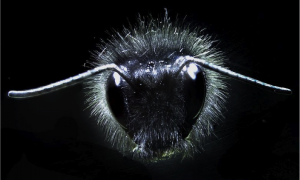By Yitong Li
It’s a given that most animals use their eyes and nose to forage, but did you know that some creatures can use electric fields to find food as well? The example we are gonna talk about today is the bumblebee. Interestingly, in addition to the visual and olfactory cues, bumblebees can also collect electric field information that helps them locate nectar by using the fluffy hairs on their little bodies.
But someone may ask: How can a flower generate an electric field? It sounds ridiculous since we have yet to hear anybody experience an electric shock by simply touching a pretty flower, but the truth is that everything has an electric field. YES, EVERYTHING! Simply put, we are all composed of atoms that have negatively charged electrons spinning around them. If you were to take some advanced physics class, you would learn that moving electrons can generate both an electric field and a magnetic field. These two fields interact with each other in a quite dynamic way and compose the electromagnetic field, which is the actual field generated by all live creatures and can sustain itself effectively. Yet these fields are normally so weak that we human beings don’t feel them at all. However, some animal species, especially those living in the dark where visual information is hard to obtain, have evolved to be able to detect these weak fields in order to identify potential preys and predators. Sharks and rays are equipped with such electrosensory structures, called electroreceptors, that enable them to respond to changes in their surrounding electric fields in the water. Terrestrial animals, such as platypuses, echidnas and bees, have also evolved similar electroreceptive organs to detect electric fields that lead them to a gourmet meal. In addition, entomologists even found out that bumblebees could detect floral electric fields in the air, but they were still puzzled by how these little creatures were able to achieve that until a few months ago.

Photograph: Gregory Sutton/Dom Clarke/Erica Morley/Daniel Robert
In June, a group of British scientists published their research on bumblebees in the Proceedings of the National Academy of Sciences (PNAS) where they reported that bumblebees use their body hairs, instead of their antennae, to detect floral electric field. If you have ever observed a bumblebee closely, you would notice that these little insects are extremely furry. Besides making them cute and fluffy, these body hairs actually contain mechanosensors, which are sensitive gadgets that can detect very subtle forces and induce neural responses. While honeybees may use their antennae to detect electric fields associated with their famous waggle dance, the antennae in bumblebees don’t play such a significant role. According to this study, both the antennae and hairs of bumblebees deflected in response to electric field stimulation, but the scientists reported that the hairs demonstrated a higher velocity and sensitivity in this induced movement compared to the antennae. They also noticed an increase in neural firing rate in hairs associated with electric field stimulation, suggesting that these hairs successfully converted the electric field signal to a response in the nervous system. In conjunction with their previous study published in the journal Science, this discovery points out that bumblebees can use their body hairs to detect floral cues. Quite amazing, isn’t it?
If you still find this unbelievable, rub a balloon against your hair a few times and then slowly move it away. If your hair is soft and long, do you see some of them get attracted towards the balloon? Fluffy bumblebees use the same “magic”, but just at a minuscule level that our naked eyes are unable to detect! Evolution has certainly geared up these tiny creatures for finding flowers!
Edited by Lauriel Earley and Temperance Rowell
